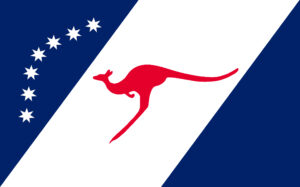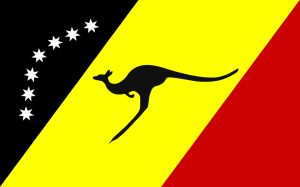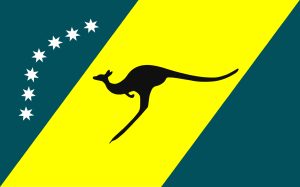Design one
What These Flags Represent
One Design, Four Identities
A shared symbol for a shared future. This design presents four official versions, National, Indigenous, Torres Strait, and Sports each with its own colours, but united by a single design. It’s a flag that honours every story, every community, and every field of pride.
Unified Flag Concept
That’s why we’ve created a Unified Flag Concept
One shared layout, used across all four flags.
Each version keeps its own colours and meaning,
but the shape stays the same.
This shared design says something powerful:
We are different, but we belong together.
It’s not about replacing history.
It’s about building a future where every Australian
can see themselves in the flag
and still know it belongs to us all.
Four Flags – One Identity
Australia has four official flags that represent different parts of our national story:
The National Flag
The Indigenous Flag
The Torres Strait Islander Flag
The Australian Sports Flag
Each one matters.
But having separate designs can make it hard to feel truly united.
Click a flag to see what it stands for. Four Flags – One Identity: bringing Australians together
Questions and Answers


Embracing a change in the Australian flag design presents an opportunity to reflect the country’s evolving identity and values, much like Canada did when they adopted a new flag in 1965. While the current flag holds historical significance, a redesigned flag could capture the contemporary spirit of Australia, representing inclusivity, diversity, and the nation’s forward-looking aspirations. Just as Canada’s change allowed them to forge a distinct national identity while maintaining their ties to the British Commonwealth, an updated Australian flag could symbolize a renewed sense of unity and progress while preserving the country’s historical connections. This shift would not diminish the importance of the current flag but rather acknowledge the dynamic nature of a nation that continues to grow and redefine itself.
The proposed new flag, featuring the kangaroo and boomerang-shaped stars, effectively symbolises Australia’s unique identity. The creation of four new official flags, such as the national flag, the Indigenous flag, the Torres Strait Islander flag, and the sports flag, allows for a diverse yet cohesive representation of Australia.
Respecting the historical significance of the flag and the sacrifices made by our dads and forefathers is paramount. The consideration for a new flag is not meant to diminish their contributions or the importance of the existing flag.
While the current flag holds immense historical value and represents the efforts of those who fought for it, the idea of a new flag is driven by the recognition that a nation, like Australia, is continuously growing and diversifying. The proposed flag seeks to embrace this evolution, past and present.
The intent is not to erase history but to create a flag that reflects the diversity of Australia while acknowledging the sacrifices and achievements of those who came before. It aims to foster a sense of inclusion, where every citizen, regardless of background, can see themselves represented in the national symbol. The proposal is a step toward ensuring that the flag continues to be a source of pride and unity, honouring the legacy of our dads and forefathers in the spirit of modern Australia.

Having four official flags in Australia, each sharing the unique design with the kangaroo and boomerang-shaped stars, fosters unity and inclusivity. While distinct in their colours with their current meanings, the shared design creates a cohesive visual identity, symbolising a diverse nation that embraces the national flag with its historic links, fosters unity and inclusivity, Indigenous heritage, Torres Strait Islander culture, and sportsmanship. This unified design ensures that any flag flown worldwide unmistakably represents Australia and the diverse facets of its identity.
 Incorporating the kangaroo on the Australian flag is crucial for global recognition. The kangaroo is a universally acknowledged symbol of Australia, ensuring that the flag becomes instantly identifiable worldwide. This recognition enhances the country’s global visibility and fosters a strong and distinctive national identity. Excluding the kangaroo would compromise this powerful association and weaken the flag’s ability to resonate internationally.
Incorporating the kangaroo on the Australian flag is crucial for global recognition. The kangaroo is a universally acknowledged symbol of Australia, ensuring that the flag becomes instantly identifiable worldwide. This recognition enhances the country’s global visibility and fosters a strong and distinctive national identity. Excluding the kangaroo would compromise this powerful association and weaken the flag’s ability to resonate internationally.
 The Qantas kangaroo on their planes symbolises a piece of Australia that travels around the world. Adding this new redesigned kangaroo to our flag instantly makes it uniquely Australian. Just as the airline’s kangaroo represents Australia’s spirit of adventure and resilience, our flag could embody those same values. Our flag represents our pride, and its global recognition, speaks volumes about our identity. Imagine the resonance it would create – just as the Qantas kangaroo does for Australia.
The Qantas kangaroo on their planes symbolises a piece of Australia that travels around the world. Adding this new redesigned kangaroo to our flag instantly makes it uniquely Australian. Just as the airline’s kangaroo represents Australia’s spirit of adventure and resilience, our flag could embody those same values. Our flag represents our pride, and its global recognition, speaks volumes about our identity. Imagine the resonance it would create – just as the Qantas kangaroo does for Australia.

The decision to exclude the Southern Cross stars from the proposed new flags is rooted in a desire to create a unique and distinctly Australian symbol that goes beyond regional associations. While the Southern Cross is shared with other countries in the Southern Hemisphere, the new design aims to forge a national identity centered around Australia’s specific characteristics and heritage.
In the proposed flag, the arrangement of 7 stars holds a symbolic meaning that resonates with the political structure of Australia. The inclusion of 6 stars representing the states and 1 star representing the territories highlights the nation’s political unity. The design also takes inspiration from the shape of a boomerang, an iconic symbol deeply connected to Australia’s Indigenous peoples who have a rich history spanning 60,000 years. Additionally, the boomerang shape pays homage to significant Australian landmarks such as the Sydney Harbour Bridge, further grounding the flag in the nation’s cultural and historical context. This approach aims to create a flag that not only reflects Australia’s political structure but also embodies its diverse cultural and natural heritage in a visually distinctive manner.

Leaning towards the New 4 Australian Flags Proposal offers several compelling reasons, primarily centered around its simplicity, recognisability, and inclusivity. The design features a simple yet impactful composition, incorporating the iconic Australian kangaroo and the unique arrangement of stars, which is shared among various official flags. Here’s why this proposal stands out:
Simple and Recognisable Design: The proposed flag design is straightforward, consisting of three colors and familiar symbols like the kangaroo and the distinctive star arrangement. This simplicity ensures easy recognition, making it instantly identifiable as uniquely Australian.
Consistency with Official Flags: The inclusion of the same design in various official flags, such as the national flag, Indigenous flag, Torres Strait Islander flag, and the sports flag, fosters a cohesive visual identity. This unity in design reinforces a collective national image while allowing for diversity and representation.
Symbolic Meaning: The star arrangement, representing the states and territories, adds depth and meaning to the flag. This symbolism enhances the flag’s connection to Australia’s political structure, providing a sense of unity and inclusivity.
Cultural Representation: The use of the kangaroo and boomerang-inspired shape not only pays homage to Indigenous culture but also reflects Australia’s unique natural and cultural heritage. This representation serves as a unifying element that resonates with the country’s diverse population.
By leaning towards the New 4 Australian Flags Proposal, Australia ensures a visually distinct and meaningful national symbol that is not only easily recognisable but also reflective of its rich cultural tapestry and inclusive spirit.



